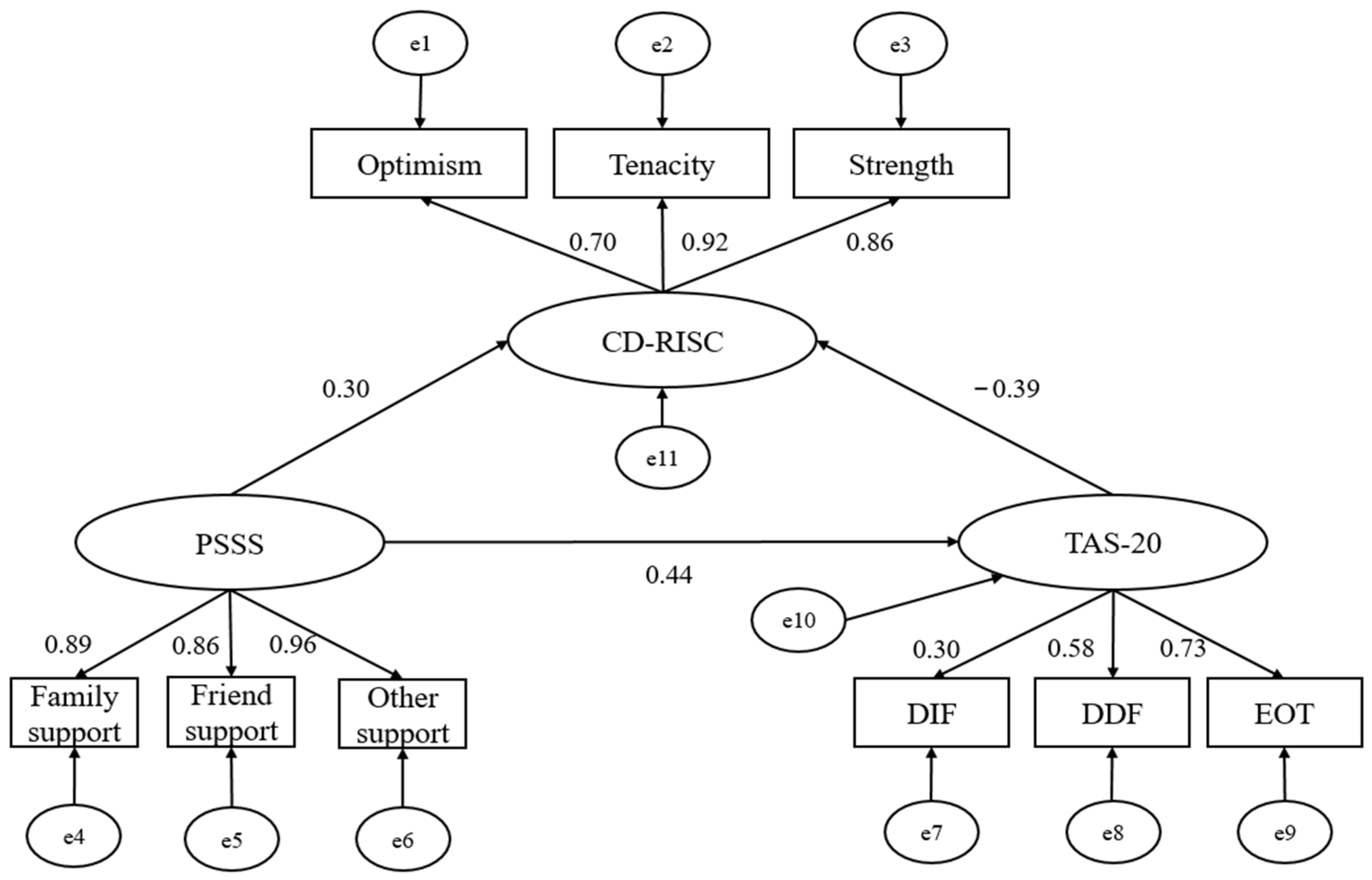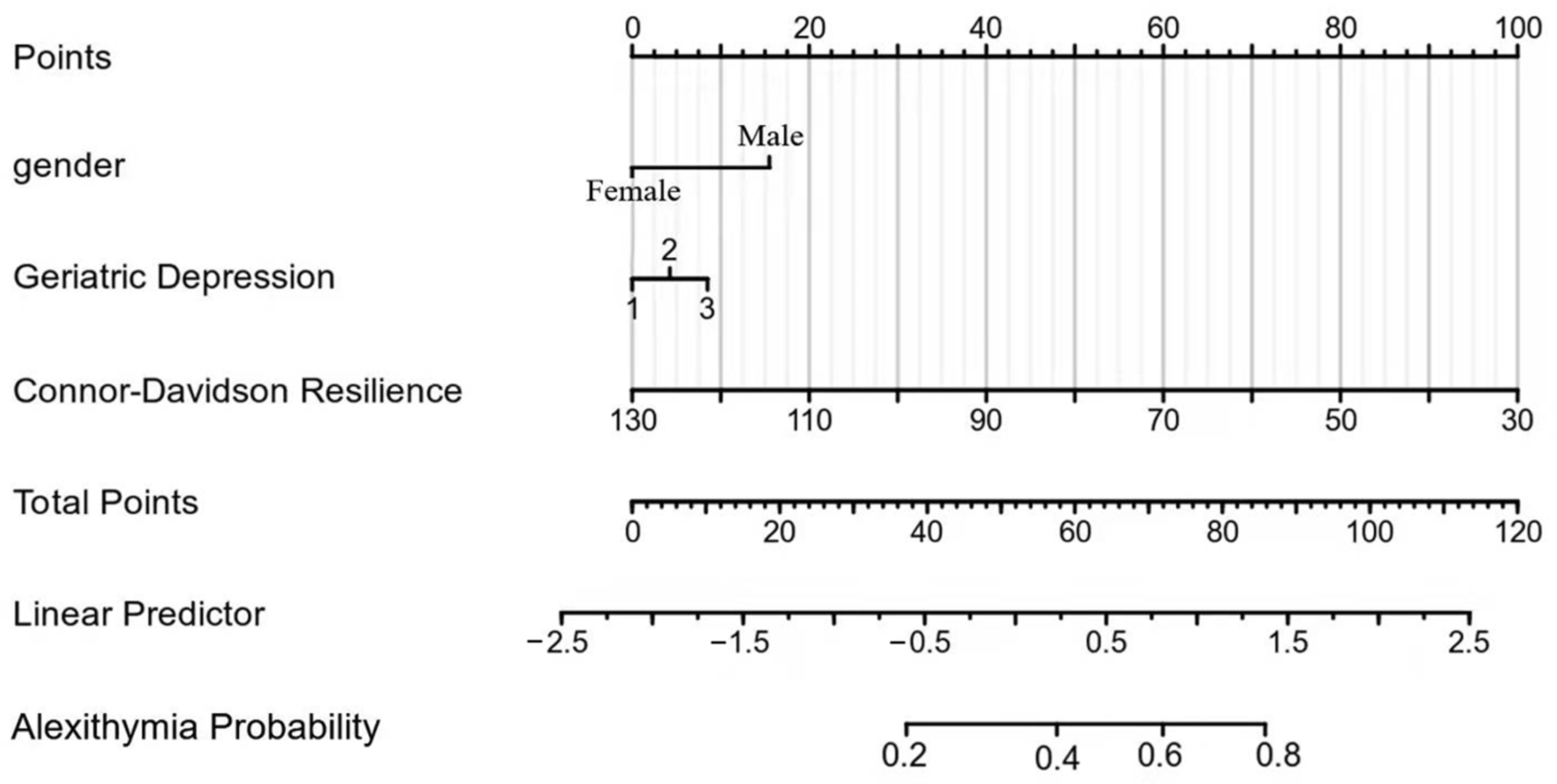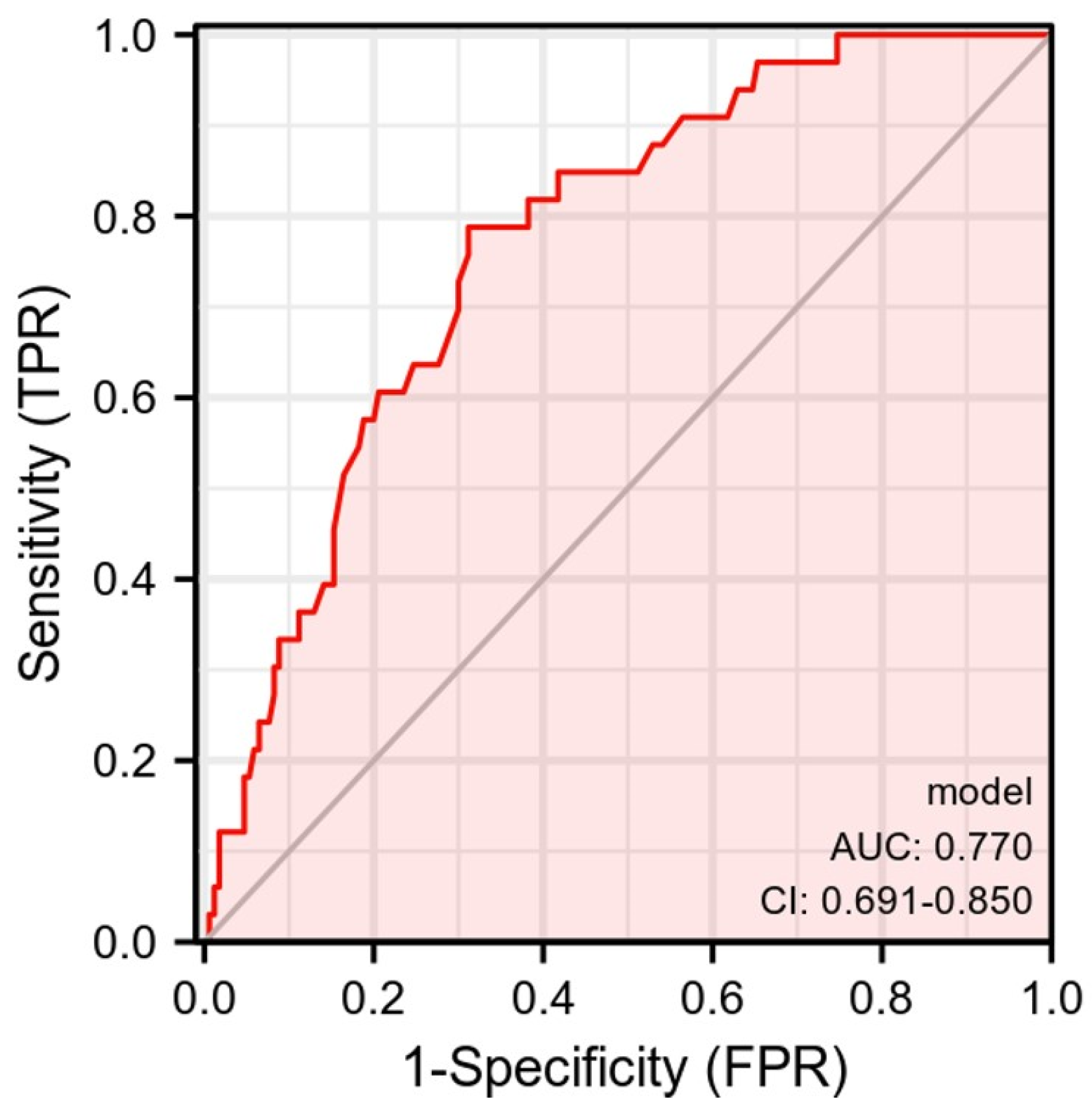Constructing and Verifying an Alexithymia Risk-Prediction Model for Older Adults with Chronic Diseases Living in Nursing Homes: A Cross-Sectional Study in China
Abstract
:1. Introduction
2. Methods
2.1. Study Design
2.2. Participants
2.3. Socio-Demographic Characteristics Questionnaire
2.4. Toronto Alexithymia Scale (TAS-20)
2.5. Geriatric Depression Scale-15 (GDS-15)
2.6. The Connor-Davidson Resilience Scale (CD-RISC)
2.7. Perceived Social Support Scale (PSSS)
2.8. Data Collection
2.9. Statistical Analysis
3. Results
3.1. Participants’ Characteristics and Univariate Analysis of Alexithymia
3.2. Correlation Analysis of Alexithymia, Depression, Psychological Resilience, and Social Support
3.3. Mediating Effect Analysis of Alexithymia, Psychological Resilience, and Perceived Social Support
3.4. Analysis of the Influencing Factors of Alexithymia
3.5. Construction of an Alexithymia Risk-Prediction Model
4. Discussion
5. Limitations
6. Conclusions
Author Contributions
Funding
Institutional Review Board Statement
Informed Consent Statement
Data Availability Statement
Conflicts of Interest
References
- ‘National Statistical Bureau of the People’s Republic of China’: The Seventh National Census Bulletin (No. 5). 2021. Available online: https://www.stats.gov.cn/xxgk/sjfb/zxfb2020/202105/t20210511_1817200.html (accessed on 20 November 2022).
- Jiang, C.H.; Zhu, F.; Qin, T.T. Relationships between Chronic Diseases and Depression among Middle-aged and Elderly People in China: A Prospective Study from CHARLS. Curr. Med. Sci. 2020, 40, 858–870. [Google Scholar] [CrossRef] [PubMed]
- Nemiah, J.C.; Freyberger, H.; Sifneos, P. Alexithymia: A view of the psychosomatic process. Mod. Trends Psychosom. Med. 1976, 3, 430–439. [Google Scholar] [CrossRef]
- Hemming, L.; Haddock, G.; Shaw, J.; Pratt, D. Alexithymia and Its Associations With Depression, Suicidality, and Aggression: An Overview of the Literature. Front. Psychiatry 2019, 10, 203. [Google Scholar] [CrossRef] [PubMed] [Green Version]
- Goerlich-Dobre, K.S.; Votinov, M.; Habel, U.; Pripfl, J.; Lamm, C. Neuroanatomical profiles of alexithymia dimensions and subtypes. Hum. Brain Mapp. 2015, 36, 3805–3818. [Google Scholar] [CrossRef] [PubMed]
- Di Tella, M.; Adenzato, M.; Catmur, C.; Miti, F.; Castelli, L.; Ardito, R.B. The role of alexithymia in social cognition: Evidence from a non-clinical population. J. Affect. Disord. 2020, 273, 482–492. [Google Scholar] [CrossRef]
- VanMeter, F.; Cicchetti, D. Resilience. Handb. Clin. Neurol. 2020, 173, 67–73. [Google Scholar] [CrossRef]
- Ong, H.L.; Vaingankar, J.A.; Abdin, E.; Sambasivam, R.; Fauziana, R.; Tan, M.E.; Chong, S.A.; Goveas, R.R.; Chiam, P.C.; Subramaniam, M. Resilience and burden in caregivers of older adults: Moderating and mediating effects of perceived social support. BMC Psychiatry 2018, 18, 27. [Google Scholar] [CrossRef] [Green Version]
- Chen, J.J.; Wang, Q.L.; Li, H.P.; Zhang, T.; Zhang, S.S.; Zhou, M.K. Family resilience, perceived social support, and individual resilience in cancer couples: Analysis using the actor-partner interdependence mediation model. Eur. J. Oncol. Nurs. Off. J. Eur. Oncol. Nurs. Soc. 2021, 52, 101932. [Google Scholar] [CrossRef]
- Posse, M.; Hällström, T.; Backenroth-Ohsako, G. Alexithymia, social support, psycho-social stress and mental health in a female population. Nord. J. Psychiatry 2002, 56, 329–334. [Google Scholar] [CrossRef]
- Von Elm, E.; Altman, D.G.; Egger, M.; Pocock, S.J.; Gøtzsche, P.C.; Vandenbroucke, J.P. The Strengthening the Reporting of Observational Studies in Epidemiology (STROBE) statement: Guidelines for reporting observational studies. PLoS Med. 2007, 4, e296. [Google Scholar] [CrossRef]
- Kendall, M.G.; Stuart, A. The Advanced Theory of Statistics, Volume 2, Inference and Relationship. In Applied Statistics, 2nd ed.; 1979; pp. 240–274. [Google Scholar]
- Bagby, R.M.; Taylor, G.J.; Parker, J.D. The Twenty-item Toronto Alexithymia Scale--II. Convergent, discriminant, and concurrent validity. J. Psychosom. Res. 1994, 38, 33–40. [Google Scholar] [CrossRef]
- Yi, J.; Yao, S.; Zhu, X. The Chinese version of the TAS-20: Reliability and validity. Chin. Ment. Health J. 2003, 17, 763–767. [Google Scholar]
- Yesavage, J.A.; Brink, T.L.; Rose, T.L.; Lum, O.; Huang, V.; Adey, M.; Leirer, V.O. Development and validation of a geriatric depression screening scale: A preliminary report. J. Psychiatr. Res. 1982, 17, 37–49. [Google Scholar] [CrossRef] [PubMed]
- Jl, S.; Ja, Y. Geriatric depression Scale (GDS): Recent evidence and developm ent of a shorter version. Clin. Gerontol. 1986, 5, 165–173. [Google Scholar]
- Connor, K.M.; Davidson, J.R. Development of a new resilience scale: The Connor-Davidson Resilience Scale (CD-RISC). Depress. Anxiety 2003, 18, 76–82. [Google Scholar] [CrossRef] [PubMed]
- Yu, X.; Zhang, J. A Comparison between the Chinese Version of Ego-Resiliency Scale and Connor-Davidson Resilience Scale. Psychol. Sci. 2007, 30, 1169–1171. [Google Scholar]
- Zimet, G.D.; Dahlem, N.W.; Zimet, S.G.; Farley, G.K. The Multidimensional Scale of Perceived Social Support. J. Personal. Assess. 1988, 52, 30–41. [Google Scholar] [CrossRef] [Green Version]
- Jiang, Q. Perceived Social Support Scale (PSSS). Chin. J. Behav. Med. 2001, 10, 41–43. [Google Scholar]
- Xu, J.; Qin, D.J.; Tian, J.L.; Sun, X.N.; Guo, Y.Q.; Wang, Q.; Meng, S.J. The status and influencing factors of Alexithymia among empty nest elderly, Chengde. Mod. Prev. Med. 2021, 48, 1246–1248+1263. [Google Scholar]
- Dirik, G.; Göcek-Yorulmaz, E. Positive Sides of the Disease: Posttraumatic Growth in Adults with Type 2 Diabetes. Behav. Med. 2018, 44, 1–10. [Google Scholar] [CrossRef]
- Ogrodniczuk, J.S.; Kealy, D.; Joyce, A.S.; Abbass, A.A. Body talk: Sex differences in the influence of alexithymia on physical complaints among psychiatric outpatients. Psychiatry Res. 2018, 261, 168–172. [Google Scholar] [CrossRef] [PubMed]
- Fietz, J.; Valencia, N.; Silani, G. Alexithymia and autistic traits as possible predictors for traits related to depression, anxiety, and stress: A multivariate statistical approach. J. Eval. Clin. Pract. 2018, 24, 901–908. [Google Scholar] [CrossRef]
- Pelizza, L.; Pupo, S. Alexithymia in adults with brittle type 1 diabetes. Acta Bio-Med. Atenei Parm. 2019, 90, 279–287. [Google Scholar] [CrossRef]
- Lenzo, V.; Barberis, N.; Cannavò, M.; Filastro, A.; Verrastro, V.; Quattropani, M.C. The relationship between alexithymia, defense mechanisms, eating disorders, anxiety and depression. Riv. Psichiatr. 2020, 55, 24–30. [Google Scholar] [CrossRef] [PubMed]
- De Berardis, D.; Fornaro, M.; Valchera, A.; Rapini, G.; Di Natale, S.; De Lauretis, I.; Serroni, N.; Orsolini, L.; Tomasetti, C.; Bustini, M.; et al. Alexithymia, resilience, somatic sensations and their relationships with suicide ideation in drug naïve patients with first-episode major depression: An exploratory study in the “real world” everyday clinical practice. Early Interv. Psychiatry 2020, 14, 336–342. [Google Scholar] [CrossRef] [PubMed]
- Jalilianhasanpour, R.; Williams, B.; Gilman, I.; Burke, M.J.; Glass, S.; Fricchione, G.L.; Keshavan, M.S.; LaFrance, W.C., Jr.; Perez, D.L. Resilience linked to personality dimensions, alexithymia and affective symptoms in motor functional neurological disorders. J. Psychosom. Res. 2018, 107, 55–61. [Google Scholar] [CrossRef]
- Ungar, M.; Theron, L. Resilience and mental health: How multisystemic processes contribute to positive outcomes. Lancet. Psychiatry 2020, 7, 441–448. [Google Scholar] [CrossRef]
- Saikkonen, S.; Karukivi, M.; Vahlberg, T.; Saarijärvi, S. Associations of social support and alexithymia with psychological distress in Finnish young adults. Scand. J. Psychol. 2018, 59, 602–609. [Google Scholar] [CrossRef]
- Cosco, T.D.; Howse, K.; Brayne, C. Healthy ageing, resilience and wellbeing. Epidemiol. Psychiatr. Sci. 2017, 26, 579–583. [Google Scholar] [CrossRef]
- Chen, L.; Wen, Y.; Zhang, J.; Sun, W.; Lui, V.W.Y.; Wei, Y.; Chen, F.; Wen, W. Prediction of radiotherapy response with a 5-microRNA signature-based nomogram in head and neck squamous cell carcinoma. Cancer Med. 2018, 7, 726–735. [Google Scholar] [CrossRef]



| Variables | n % | M ± SD | F/t | p-Value |
|---|---|---|---|---|
| Age (years) | 0.979 | 0.42 | ||
| ≤60 | 4 (2.0) | 46.00 ± 13.88 | ||
| 61~70 | 28 (13.8) | 45.39 ± 7.42 | ||
| 71~80 | 49 (24.1) | 45.20 ± 10.53 | ||
| 81~90 | 94 (46.3) | 42.47 ± 9.75 | ||
| ≥91 | 28 (13.8) | 44.25 ± 8.41 | ||
| Gender | 2.745 | 0.007 | ||
| Male | 81 (39.9) | 46.07 ± 10.14 | ||
| Female | 122 (60.1) | 42.37 ± 8.91 | ||
| Marital status | 1.111 | 0.346 | ||
| Single | 3 (1.5) | 43.33 ± 4.93 | ||
| Married | 51 (25.1) | 44.41 ± 10.94 | ||
| Widowed | 139 (68.5) | 43.29 ± 9.10 | ||
| Separated | 10 (4.9) | 48.8 ± 9.10 | ||
| Number of children | 0.563 | 0.64 | ||
| 0 | 10 (4.9) | 44.30 ± 4.72 | ||
| 1 | 38 (18.7) | 43.16 ± 8.28 | ||
| 2 | 87 (42.9) | 44.80 ± 10.48 | ||
| ≥3 | 68 (33.5) | 42.94 ± 9.60 | ||
| Time in nursing homes (years) | 2.089 | 0.127 | ||
| <1 | 53 (26.1) | 42.04 ± 8.70 | ||
| 1~5 | 91 (44.8) | 45.27 ± 10.95 | ||
| ≥5 | 59 (29.1) | 43.27 ± 7.67 | ||
| Occupation | 2.11 | 0.081 | ||
| Farmer | 9 (4.4) | 47.89 ± 9.01 | ||
| Self-employed households | 13 (6.4) | 46.62 ± 10.74 | ||
| Staff | 50 (24.6) | 45.80 ± 9.34 | ||
| Institutional personnel | 96 (47.3) | 43.07 ± 9.70 | ||
| Others | 35 (17.2) | 41.11 ± 8.56 | ||
| Education level | 2.617 | 0.052 | ||
| Primary school | 43 (21.2) | 46.12 ± 8.96 | ||
| Junior high school | 61 (30.0) | 42.89 ± 8.60 | ||
| High school | 44 (21.7) | 45.73 ± 10.65 | ||
| Bachelor/Master/PhD | 55 (27.1) | 41.64 ± 9.73 | ||
| Location of nursing home | −2.03 | 0.044 | ||
| Countryside | 32 (15.8) | 40.72 ± 9.05 | ||
| City | 171 (84.2) | 44.43 ± 9.58 | ||
| Main economic sources | 0.879 | 0.453 | ||
| Children | 59 (29.1) | 45.27 ± 9.51 | ||
| Government | 2 (1.0) | 41.50 ± 0.71 | ||
| Own | 138 (68.0) | 43.41 ± 9.74 | ||
| Others | 4 (2.0) | 39.25 ± 2.50 | ||
| Main reason for staying in the nursing home | 0.705 | 0.495 | ||
| No children | 9 (4.4) | 46.44 ± 8.17 | ||
| Reduce burden on children | 57 (28.1) | 44.63 ± 9.27 | ||
| Receive professional care | 137 (67.5) | 43.35 ± 9.79 | ||
| Frequency of friends’ or relatives’ visits | 1.395 | 0.228 | ||
| Never | 8 (3.9) | 40.38 ± 11.26 | ||
| Weekly | 91 (44.8) | 45.73 ± 10.49 | ||
| Fortnightly | 31 (15.3) | 42.94 ± 8.70 | ||
| Triweekly | 4 (2.0) | 41.25 ± 4.79 | ||
| Monthly | 23 (11.3) | 42.70 ± 7.35 | ||
| More than a month | 46 (22.7) | 42.15 ± 8.89 | ||
| Back home during festivals | 1.069 | 0.286 | ||
| Yes | 97 (47.8) | 44.60 ± 9.72 | ||
| No | 106 (52.2) | 43.16 ± 9.43 | ||
| Self-care ability | 5.22 | 0.006 | ||
| Yes | 116 (57.1) | 42.12 ± 8.42 | ||
| Partly | 81 (39.9) | 46.46 ± 10.70 | ||
| No | 6 (3.0) | 42.00 ± 7.32 | ||
| Satisfaction with accommodation | 0.967 | 0.427 | ||
| Very dissatisfied | 1 (0.5) | 40.50 ± 11.62 | ||
| Dissatisfied | 4 (2.0) | 38.25 ± 6.95 | ||
| Neutral | 25 (12.3) | 45.08 ± 8.03 | ||
| Satisfied | 117 (57.6) | 44.53 ± 10.74 | ||
| Very satisfied | 56 (27.6) | 42.55 ± 7.41 | ||
| Satisfaction with food | 1.346 | 0.254 | ||
| Very dissatisfied | 9 (4.4) | 43.44 ± 14.43 | ||
| Dissatisfied | 34 (16.7) | 43.47 ± 9.30 | ||
| Neutral | 42 (20.7) | 41.50 ± 6.57 | ||
| Satisfied | 94 (46.3) | 45.37 ± 10.74 | ||
| Very satisfied | 24 (11.8) | 42.67 ± 6.55 | ||
| Satisfaction with caregivers | 0.776 | 0.542 | ||
| Very dissatisfied | 5 (2.5) | 41.00 ± 8.52 | ||
| Dissatisfied | 8 (3.9) | 47.00 ± 9.30 | ||
| Neutral | 22 (10.8) | 41.95 ± 8.64 | ||
| Satisfied | 102 (50.2) | 44.59 ± 10.54 | ||
| Very satisfied | 66 (32.5) | 43.17 ± 8.35 | ||
| Variables | DIF | DDF | EOT | Alexithymia |
|---|---|---|---|---|
| GDS-15 | 0.364 ** | 0.129 | 0.122 | 0.300 ** |
| CD-RISC | −0.353 ** | 0.016 | −0.264 ** | −0.315 ** |
| Tenacity | −0.375 ** | 0.015 | −0.261 ** | −0.327 ** |
| Strength | −0.319 ** | 0.038 | −0.232 ** | −0.275 ** |
| Optimism | −0.156 * | −0.029 | −0.192 ** | −0.184 ** |
| PSSS | −0.164 * | 0.083 | −0.250 ** | −0.182 ** |
| Family support | −0.080 | 0.139 * | −0.152 * | −0.074 |
| Friend support | −0.277 ** | 0.016 | −0.311 ** | −0.293 ** |
| Other support | −0.053 | 0.063 | −0.181 ** | −0.093 |
| B | SE | Β | t | p-Value | |
|---|---|---|---|---|---|
| Constant | 59.440 | 4.631 | 11.504 | <0.001 | |
| Gender | −3.297 | 1.270 | 0.133 | −2.596 | 0.010 |
| GDS-15 | 0.493 | 0.189 | 0.383 | 2.601 | 0.010 |
| CD-RISC | −0.138 | 0.043 | 0.335 | −3.234 | 0.001 |
Publisher’s Note: MDPI stays neutral with regard to jurisdictional claims in published maps and institutional affiliations. |
© 2022 by the authors. Licensee MDPI, Basel, Switzerland. This article is an open access article distributed under the terms and conditions of the Creative Commons Attribution (CC BY) license (https://creativecommons.org/licenses/by/4.0/).
Share and Cite
Wen, J.; Wu, Y.; Peng, L.; Chen, S.; Yuan, J.; Wang, W.; Cong, L. Constructing and Verifying an Alexithymia Risk-Prediction Model for Older Adults with Chronic Diseases Living in Nursing Homes: A Cross-Sectional Study in China. Geriatrics 2022, 7, 139. https://doi.org/10.3390/geriatrics7060139
Wen J, Wu Y, Peng L, Chen S, Yuan J, Wang W, Cong L. Constructing and Verifying an Alexithymia Risk-Prediction Model for Older Adults with Chronic Diseases Living in Nursing Homes: A Cross-Sectional Study in China. Geriatrics. 2022; 7(6):139. https://doi.org/10.3390/geriatrics7060139
Chicago/Turabian StyleWen, Jing, Ying Wu, Lixia Peng, Siyi Chen, Jiayang Yuan, Weihong Wang, and Li Cong. 2022. "Constructing and Verifying an Alexithymia Risk-Prediction Model for Older Adults with Chronic Diseases Living in Nursing Homes: A Cross-Sectional Study in China" Geriatrics 7, no. 6: 139. https://doi.org/10.3390/geriatrics7060139





